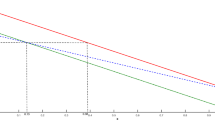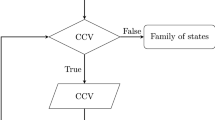Abstract
This article proposes an efficient way of calculating the geometric measure of entanglement using tensor decomposition methods. The connection between these two concepts is explored using the tensor representation of the wavefunction. Numerical examples are benchmarked and compared. Furthermore, we search for highly entangled qubit states to show the applicability of this method.




Similar content being viewed by others
References
Wei, T.C., Goldbart, P.M.: Geometric measure of entanglement and applications to bipartite and multipartite quantum states. Phys. Rev. A 68, 042307 (2003). doi:10.1103/PhysRevA.68.042307
Shimony, A.: Degree of entanglement. Ann. New York Acad. Sci. 755(1), 675 (1995). doi:10.1111/j.1749-6632.1995.tb39008.x
Barnum, H., Linden, N.: Monotones and invariants for multi-particle quantum states. J. Phys. A Math. Gen. 34(35), 6787 (2001). http://stacks.iop.org/0305-4470/34/i=35/a=305
Aulbach, M., Markham, D., Murao, M.: The maximally entangled symmetric state in terms of the geometric measure. New J. Phys. 12(7), 073025 (2010). http://stacks.iop.org/1367-2630/12/i=7/a=073025
Streltsov, A., Kampermann, H., Bruß, D.: Simple algorithm for computing the geometric measure of entanglement. Phys. Rev. A 84, 022323 (2011). doi:10.1103/PhysRevA.84.022323
Hu, S., Qi, L., Zhang, G.: Computing the geometric measure of entanglement of multipartite pure states by means of non-negative tensors. Phys. Rev. A 93, 012304 (2016). doi:10.1103/PhysRevA.93.012304
Verstraete, F., Murg, V., Cirac, J.: Matrix product states, projected entangled pair states, and variational renormalization group methods for quantum spin systems. Adv. Phys. 57(2), 143 (2008). doi:10.1080/14789940801912366
Ni, G., Bai, M.: Spherical optimization with complex variables for computing US-eigenpairs. Comput. Optim. Appl. 65(3), 799 (2016). doi:10.1007/s10589-016-9848-7
Curtef, O., Dirr, G., Helmke, U.: Conjugate gradient algorithms for best rank-1 approximation of tensors. PAMM 7(1), 1062201 (2007). doi:10.1002/pamm.200700706
Ni, G., Qi, L., Bai, M.: Geometric measure of entanglement and U-Eigenvalues of tensors. SIAM J. Matrix Anal. Appl. 35(1), 73 (2014). doi:10.1137/120892891
Enríquez, M., Puchała, Z., Życzkowski, K.: Minimal Rényi–Ingarden–Urbanik entropy of multipartite quantum states. Entropy 17(7), 5063 (2015). doi:10.3390/e17075063
Raussendorf, R., Briegel, H.J.: A one-way quantum computer. Phys. Rev. Lett. 86, 5188 (2001). doi:10.1103/PhysRevLett.86.5188
Gour, G., Wallach, N.R.: All maximally entangled four-qubit states. J. Math. Phys. 51(11), 112201 (2010). doi:10.1063/1.3511477
Kolda, T.G., Bader, B.W.: Tensor decompositions and applications. SIAM Rev. 51(3), 455 (2009). doi:10.1137/07070111X
Brody, D.C., Hughston, L.P.: Geometric quantum mechanics. J. Geom. Phys. 38(1), 19 (2001). doi:10.1016/S0393-0440(00)00052-8
Kapteyn, A., Neudecker, H., Wansbeek, T.: An approach ton-mode components analysis. Psychometrika 51(2), 269 (1986). doi:10.1007/BF02293984
Bader, B.W., Kolda, T.G.: Matlab tensor toolbox version 2.6. Available online. (2015). http://www.sandia.gov/~tgkolda/TensorToolbox/
Lathauwer, L.D., Moor, B.D., Vandewalle, J.: On the best rank-1 and rank-(R1, R2, RN) Approximation of higher-order tensors. SIAM J. Matrix Anal. Appl. 21(4), 1324 (2000). doi:10.1137/S0895479898346995
Blasone, M., Dell’Anno, F., De Siena, S., Illuminati, F.: Hierarchies of geometric entanglement. Phys. Rev. A 77, 062304 (2008). doi:10.1103/PhysRevA.77.062304
Qi, L.: The best rank-one approximation ratio of a tensor space. SIAM J. Matrix Anal. Appl. 32(2), 430 (2011). doi:10.1137/100795802
Higuchi, A., Sudbery, A.: How entangled can two couples get? Phys. Lett. A 273(4), 213 (2000). doi:10.1016/S0375-9601(00)00480-1
Enríquez, M., Wintrowicz, I., Życzkowski, K.: Maximally entangled multipartite states: a brief survey. J. Phys. Conf. Ser 698(1), 012003 (2016). http://stacks.iop.org/1742-6596/698/i=1/a=012003
Stepney, S., Sudbery, A., Braunstein, S.L.: Searching for highly entangled multi-qubit states. J. Phys. A Math. Gen. 38(5), 1119 (2005). http://stacks.iop.org/0305-4470/38/i=5/a=013
Borras, A., Plastino, A.R., Batle, J., Zander, C., Casas, M., Plastino, A.: Multiqubit systems: highly entangled states and entanglement distribution. J. Phys. A Math. Theor. 40(44), 13407 (2007). http://stacks.iop.org/1751-8121/40/i=44/a=018
Wei, T.C.: Entanglement under the renormalization-group transformations on quantum states and in quantum phase transitions. Phys. Rev. A 81, 062313 (2010). doi:10.1103/PhysRevA.81.062313
Shi, Q.Q., Wang, H.L., Li, S.H., Cho, S.Y., Batchelor, M.T., Zhou, H.Q.: Geometric entanglement and quantum phase transitions in two-dimensional quantum lattice models. Phys. Rev. A 93, 062341 (2016). doi:10.1103/PhysRevA.93.062341
Hillar, C.J., Lim, L.H.: Most tensor problems are NP-hard. ACM 60(6), 45:1 (2013). doi:10.1145/2512329
Huang, Y.: Computing quantum discord is NP-complete. New J. Phys. 16(3), 033027 (2014). http://stacks.iop.org/1367-2630/16/i=3/a=033027
Acknowledgements
I want to give my sincere thanks to the Ohio State University Physics Department who financially supported my study. This research did not receive any specific grant from funding agencies in the public, commercial or not-for-profit sectors.
Author information
Authors and Affiliations
Corresponding author
Rights and permissions
About this article
Cite this article
Teng, P. Accurate calculation of the geometric measure of entanglement for multipartite quantum states. Quantum Inf Process 16, 181 (2017). https://doi.org/10.1007/s11128-017-1633-8
Received:
Accepted:
Published:
DOI: https://doi.org/10.1007/s11128-017-1633-8




